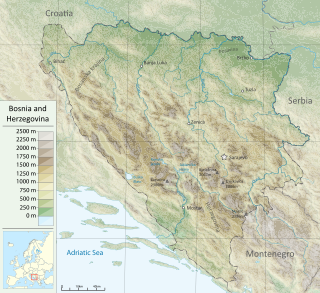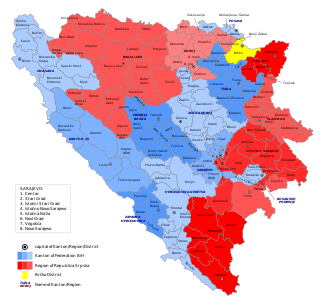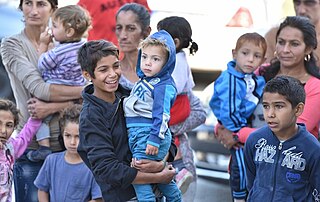Related Research Articles

Bosnia and Herzegovina is located in Southeastern Europe, in the western Balkans. It has a 932 km (579 mi) border with Croatia to the north and southwest, a 357 km (222 mi) border with Serbia to the east, and a 249 km (155 mi) border with Montenegro to the southeast. It borders the Adriatic Sea along its 20 km (12 mi) coastline.

Bijeljina is a city and municipality in Bosnia and Herzegovina. It is the provincial center of Semberija, a geographic region in the country's northeast. Administratively, Bijeljina is part of the Republika Srpska entity. As of 2013, it has a population of 107,715 inhabitants.

Gradiška, formerly Bosanska Gradiška, is a city and municipality located in the northwestern region of Republika Srpska, the entity of Bosnia and Herzegovina. As of 2013, it has a population of 51,727 inhabitants, while the city of Gradiška has a population of 14,368 inhabitants.

In Bosnia and Herzegovina, the smallest administrative unit is the municipality. Prior to the 1992–95 Bosnian War there were 109 municipalities in what was then Socialist Republic of Bosnia and Herzegovina. Ten of these formed the area of the capital Sarajevo.

The First League of the Republika Srpska is a second level football competition in Bosnia and Herzegovina.
Bosnia and Herzegovina, like many countries is made of geographical and historical and political regions. The current geopolitical regions were finalised with the signing of the Dayton Agreement.

The Xoraxane in Bosnia and Herzegovina are the largest of the 17 national minorities in the country, although—due to the stigma attached to the label—this is often not reflected in statistics and censuses.
Television in Bosnia and Herzegovina was first introduced in 1961. Out of 94 TV stations, 71 are commercial, 20 are public, while 3 public services are funded through subscription.
The 2012–2013 season was the club's 65th season in history and their 19th consecutive season in the top flight of Bosnian football.
In 2014-2015 season, FK Sarajevo played in the Bosnian Premier League and became the champion for the fifth time in the history of the club.

RSG Radio is a Bosnian commercial radio station, broadcasting from Sarajevo.
Municipal elections were held in Bosnia and Herzegovina on 15 November 2020 to elect mayors and assemblies in 143 municipalities. Originally scheduled for 4 October, they were postponed due to a lack of funds.
The 2019–20 First League of the Republika Srpska was the twenty-fifth season of the First League of the Republika Srpska, the second tier football league of Bosnia and Herzegovina, since its original establishment and the eighteenth as a second tier league. The season began on 10 August 2019 and ended abruptly on 8 May 2020 due to the COVID-19 pandemic in Bosnia and Herzegovina, with Krupa getting promoted to the Premier League of Bosnia and Herzegovina and no one getting relegated.
References
- ↑ "HIGHER EDUCATION 2018/2019" (PDF). fzs.ba (in Bosnian). Retrieved 29 November 2019.
- ↑ "ENROLLED STUDENTS" (PDF). rzs.rs.ba. Retrieved 29 November 2019.
- ↑ http://www.blc.edu.ba Banja Luka College
- ↑ http://kfbl.edu.ba/ Banja Luka College of Communications Kappa Phi
- ↑ "Pocetna - Evropski univerzitet Brčko distrikt". Evropski univerzitet Brčko distrikt. 30 May 2020. Retrieved 10 January 2021.
- ↑ High college for applied and law sciences "Prometej"
- ↑ http://www.primus-gradiska.com Archived 2018-04-19 at the Wayback Machine High college for business management "PRIMUS"
- ↑ http://www.ibu.edu.ba/ International Burch University
- ↑ http://www.univerzitetgorazde.com/ International University of Goražde
- ↑ http://www.ius.edu.ba International University of Sarajevo
- ↑ http://www.unt.ba/ University of Travnik
- ↑ http://www.apeiron-uni.eu Paneuropean University ApeiroN
- ↑ http://www.ssst.edu.ba Sarajevo School of Science and Technology
- ↑ http://www.spu.ba Slobomir P University
- ↑ http://www.koledzprijedor.org University College of Prijedor
- ↑ http://www.sveherc-edu.com University of Herzegowina
- ↑ "Home". ckm.ba.
- ↑ http://unvi.edu.ba/ University of Vitez
- ↑ http://www.sinergija.edu.ba University Sinergija
- ↑ "Univerzitet PIM Banja Luka". Univerzitet PIM. Retrieved 2020-07-30.